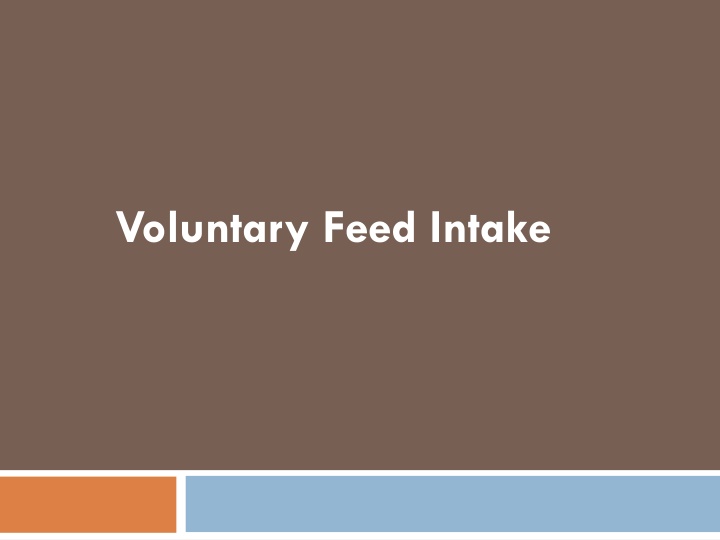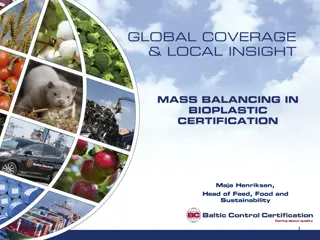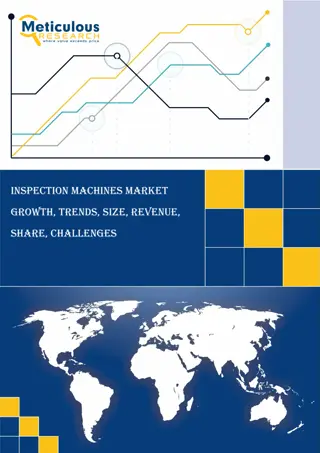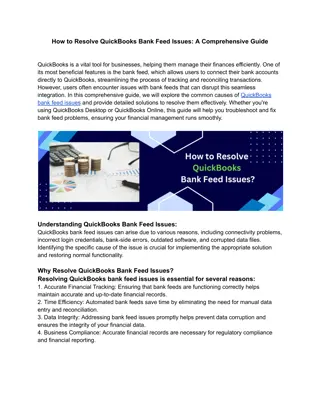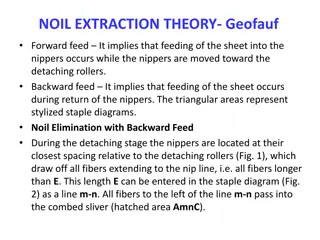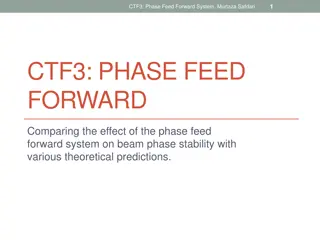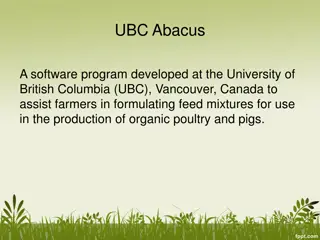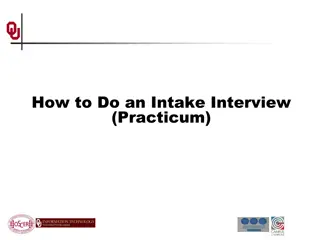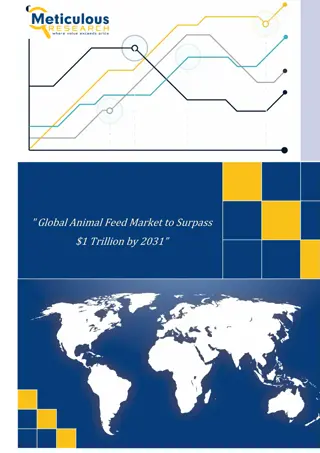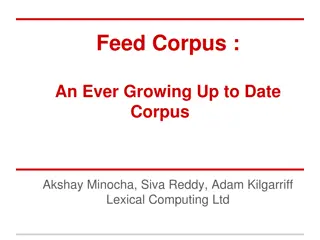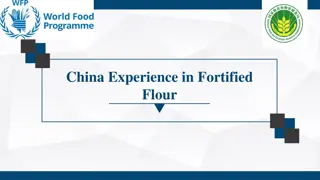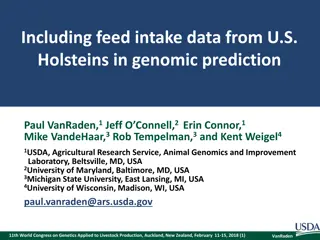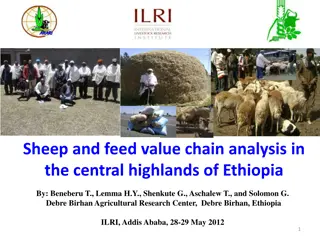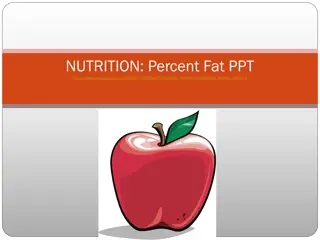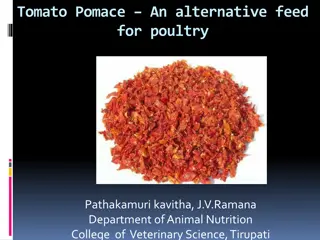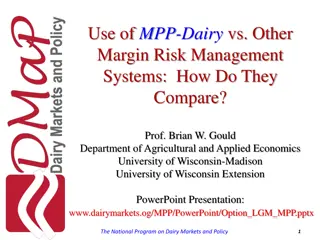Voluntary Feed Intake
Voluntary feed intake plays a crucial role in animal nutrition, impacting production and health outcomes. Factors influencing feed intake, such as quality, quantity, and palatability, are discussed in detail. Learn about the significance of reduced feed intake and its implications on animal performance. Additionally, explore the concepts of total nutrient supply, intake regulation mechanisms, and theoretical aspects related to feed intake.
Download Presentation

Please find below an Image/Link to download the presentation.
The content on the website is provided AS IS for your information and personal use only. It may not be sold, licensed, or shared on other websites without obtaining consent from the author.If you encounter any issues during the download, it is possible that the publisher has removed the file from their server.
You are allowed to download the files provided on this website for personal or commercial use, subject to the condition that they are used lawfully. All files are the property of their respective owners.
The content on the website is provided AS IS for your information and personal use only. It may not be sold, licensed, or shared on other websites without obtaining consent from the author.
E N D
Presentation Transcript
Introduction Amount of feed consumed in a given time period when feed is freely accessible (ad libitum) Too low production Too much fat/energy deposition Regulated mostly relative to energy requirement
Reduced feed intake; some examples Ration characteristics Too much fiber; bulky Physiological state Competition for space: late pregnancy Sudden & significant increase in energy requirement: early lactation Environmental factors Temperature, humidity, time,
Feed Intake voluntary feed intake the "quality" of a feed for forages greater intake indicates faster digestion rate for grain greater intake may indicate less energy dense another factor of intake is palatability: blood meal: best protein source but unpalatable Crested wheatgrass: high yield but low consumption
Feed Intake total nutrient supply to the animal is a function of intake and digestibility the greater the intake, the greater the nutrient supply above maintenance Amount of growth/milk Calculate: rate of gain/daily milk efficiency of gain or of milk production Physical fill: distention of the gut tells the animal to stop eating Chemostatic: absorbed nutrient in blood is monitored by receptors in brain - tells animal to stop eating
Chemostatic Thermostatic Distension ME INTAKE Intake Nutritive Value
Theoretical aspects: Single-factor theories 1) gastric distension hunger contractions of stomach - Physical capacity of the rumen - Digestibility - Passage rate
Intake of hay by sheep w/ or w/o 150g of polypropylene fibers to the rumen on d 26(Welch, 1967) Forage intake: negative correlation w/ abdominal fat Positive correlation w/ empty reticulo-rumen weight
Single-factor theories 2) Glucostatic theory Voluntary feed intake is controlled by glucose level - Relatively constant (up after a meal; low right before a meal) -Insulin concentrations Hypothalamus blood glucose Is it true in ruminants? what about energy status? intake utilization
Single-factor theories 3) Thermostatic theory eat to keep warm & quit to prevent hyperthermia - In some experiments, cooling/warming the anterior hypothalamus Change in feed intake - Constant body temperature - Food intake - Reduced intake - Over-eating heat production body reserves activation of heat loss mechanisms
Single-factor theories 4) Lipostatic theory Adult: maintaining body fat content Surgical removal of inguinal fat: hyperphagia returning to pre-operation BW & fat content = Ruminants
Multi-factor theories 1) Energostatic Energy supply to specific tissues Example: in sheep GH -sensory factors: how palatable Feed back Feed forward palatability Viscera: Hormones Growth factors nutrients
Negative feed back Oro-pharyngeal receptors Ruminants: Long time for chewing Mechanoreceptors Reticulo-rumen: in rumen capacity when requirements are increased Reticulum: wall sensors; physical stimulation Intestine: some evidence but all minor I. II.
Cont. Chemo-receptors - No evidence for glucose negative feed back - VFA s have different effects; - pH Intra- rumen infusion of VFA; goat C3 Reduction in feed intake C2 VFA C4 VFAs concentrations
Cont. Osmo-receptors rumen osmolarity voluntary feed intake Liver receptors Propionate infusion hepatic uptake of propionate insulin-induced increase in
Cont. Temperature receptors rumen temperature: intake, and vise versa Metabolites: Glucose Short chain FA Fats & LCFA Glycerol
Cont. Hormones Insulin Glucagon Cholecystokinin (CCK)
Effect on feed intake after injection in lateral ventricle with CCK antibody(Della Fera & Blaine, 1981)
Dietary factors affecting feed intake Digestibility/energy content of the ration Ration characteristics Roughage content, grain, processing, VanSoest, 1965: I = 110-1716/(100-CWC) I: voluntary intake (g DM/kg BW0.75) CWC: cell wall constituents (r = 0.78)
Feed intake & digestibility of the diet by fat (open) and thin (closed) cows ( , for straw; , for hay; , for concentrate)
Intake of high fiber roughages - Rate at which feed is digested (hr) - Digestibility, % - Rate at which feed particle is broken down in the rumen (hr) - Rumen capacity, liter Rate at which feed is digested (hr) 1 2 3 Digestibility, %
Cont. Dietary protein and forage intake (Millford & Minsen, 1966) Crude protein %
Feed intake of cows: fat (), medium () and thin () at calving; a=actual, b=predicted (Forbes, 1984)
Effect of ambient temperature on voluntary feed intake in laying hen (a), growing pig (b), growing cattle ( c ), and dairy cow (d) Effective temperature (o C)
Changes in milk yield, feed intake, and body gain (Monteiro, 1972)
Effect of single vs. twin on forage intake of late pregnant ewes; single ( ); twin ( ) (Forbes, 1968)
Prediction of feed intake Simple regression equations Example: DMI (g/d) = 172 BW0.61 (cattle; used by ARC, 1980) DOMI = 1276 50.7 RTOM (tested for several forages) Dry organic matter intake (g/d) mean retention time of organic matter in the rumen (hr)
Cont. Multiple regression equations: Example: DMI (kg/d) = 0.025 BW (kg) + 0.1 MY (kg/d) (MAFF, 1975) DMI (kg/d) = 0.025 BW (kg) + 0.2 MY (kg/d) (Neal et al., 1984) For the last 4 wk of lactation (Curran et al., 1970) DOMI = -847+25 (digestibility, %) - 0.19 (digestibility, %)2 For the first 4 wk of lactation (Curran et al., 1970) DOMI = -14.9+0.22 ( BW, kg/d)+0.64(concentrate intake, g/kgBW0.75)+0.46 (digestibility, %) - 0.17 (MY, kg/d)+ 0.003 (MY2)
Dry Matter Intake NRC, 1989 = 0.012 BW + 0.12 BW + 12.2 MPY-0.011 Days pregnant NRC, 2001 = (0.372 FCM) + [(0.0968 BW) x 1 -e ((-0.192 x WOL + 3.67))] FCM: fat-corrected milk BW: body weight WOL: week of lactation
